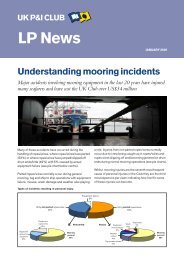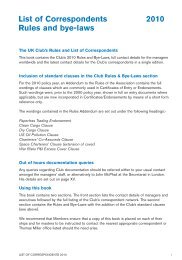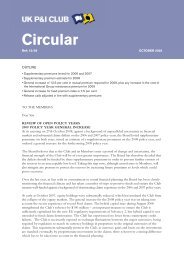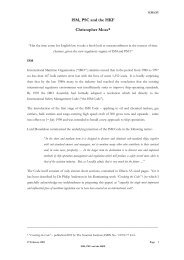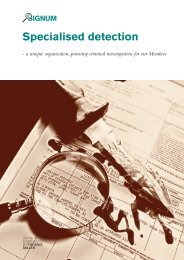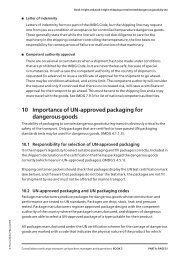Biofuels - UK P&I
Biofuels - UK P&I
Biofuels - UK P&I
Create successful ePaper yourself
Turn your PDF publications into a flip-book with our unique Google optimized e-Paper software.
emissions, seemed an ideal solution<br />
for governments facing increasingly<br />
difficult decisions with regard to the<br />
links between pollution and climate<br />
change, and legislative targets were<br />
quickly put in place mandating the<br />
integration of biofuels into the<br />
current transport fuel infrastructure.<br />
However, it was not long before<br />
serious questions were raised with regard to the<br />
environmental credentials and overall sustainability of<br />
the commercially available biofuels. Issues included<br />
the use of crops which would normally be used for food<br />
being put into biofuel production, the questionable<br />
carbon dioxide emissions savings when considering the<br />
overall production process (‘wells to wheels’),<br />
deforestation to make way for biofuel crop plantations<br />
and the use of environmentally harmful fertilisers and<br />
pesticides employed in growing the crop feedstock.<br />
Indeed it was suggested by some parties that biofuels<br />
could in reality be causing more harm than good to the<br />
environment.<br />
Amid these growing concerns, the <strong>UK</strong> Government has<br />
recently decided to amend the targets set out in the<br />
Renewable Transport Fuel Obligation (RTFO), a<br />
directive aimed at reducing greenhouse gas emissions<br />
from road transport. The RTFO requires that by<br />
2013/14, 5% by volume of all fuel sold in <strong>UK</strong> forecourts<br />
is to come from renewable sources, with intermediate<br />
targets of approximately 3.5%, 4% and 4.5% for the<br />
periods 2010/11, 2011/12 and 2012/13 respectively.<br />
These targets represent a slowdown in the required<br />
biofuels targets, but they are likely to be reviewed in<br />
2013/14 in order to assess the progress of the <strong>UK</strong><br />
RTFO in complying with the wider EU initiative to<br />
reduce carbon emissions, the Renewable Energy<br />
Directive. This directive was recently reviewed and<br />
agreed in December 2008, and mandates that by 2020,<br />
10 per cent of all automotive fuel consumption by<br />
energy content should be sourced from renewable<br />
energy sources.<br />
Amid all the uncertainty, it appears likely that the<br />
worldwide push for increasing biofuel use as a means<br />
of reducing overall carbon dioxide emissions will<br />
continue, and one can reasonably expect the biofuels<br />
market to continue to grow. Much of the biofuel is<br />
shipped internationally by sea. For example, first half<br />
figures for the 2008/2009 period indicate that 670<br />
million litres of biofuels were supplied to the <strong>UK</strong><br />
transport market. Only 8% of the biofuel supplied was<br />
produced from within the <strong>UK</strong>, such that 92%<br />
(approximately 616 million litres) of biofuel was<br />
imported. A recent report by Pike Research estimated<br />
that the global biodiesel and ethanol markets are likely<br />
to reach US$ 247 billion in sales by 2020, up from<br />
US$ 76 billion in sales predicted for 2010.<br />
In order to meet the necessary targets, the quantity of<br />
biofuels shipped both into the <strong>UK</strong> and worldwide is<br />
likely to increase, and it is therefore important for those<br />
involved in the carriage of biofuels to understand the<br />
issues that need to be considered if these products are<br />
to be carried safely, without risking damage to either<br />
the ship or the cargo.<br />
Current biofuels<br />
There are presently two main classes of biofuels in<br />
widespread use; biodiesel (or more correctly, FAME)<br />
and bioethanol. The two are very different in their<br />
properties and therefore have different issues to<br />
consider if they are to be safely shipped, handled,<br />
stored and used. Each will be considered in turn.<br />
FAME/Biodiesel<br />
Biodiesel is a fuel derived from vegetable oils or animal<br />
fats, although the term ‘biodiesel’ is too vague a<br />
description and we therefore use the more correct<br />
terminology, Fatty Acid Methyl Esters (FAME), when<br />
discussing these fuels. FAME is the product of reacting<br />
a vegetable oil or animal fat with an alcohol (methanol,<br />
a petrochemical which is generally derived from natural<br />
gas or coal) in a process known as transesterification.<br />
When compared to conventional diesel derived from<br />
crude oil, vegetable oils and animal fats generally have<br />
higher viscosities (which means they are more difficult<br />
to pump and store without heating) and are more<br />
unstable (which means they are more likely to degrade<br />
during storage, handling and end-use). The<br />
transesterification process brings the properties of the<br />
raw materials closer to those of a conventional diesel,<br />
making the product more suitable for use as a road<br />
transport fuel. However, whilst the FAME produced can<br />
be used neat as a fuel, it is more commonly blended<br />
with conventional petroleum diesel for use in diesel<br />
engines.<br />
The ASTM has described a system of nomenclature for<br />
naming FAME/diesel blends (see ASTM D6751). Pure




